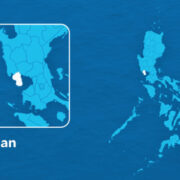The rule of law in the besieged China Sea

The rule of law is besieged in the South China Sea and the East China Sea because of the aggressive Chinese claims of ownership and sovereignty over Taiwan, almost the entire SCS, and over islets in the ECS, and the challenges posed by the riparian states and the Western powers.
CHINA AVOWS A LONG AND GLORIOUS HISTORY that, per my column on June 20, 2021, rivals Egypt and its pharaohs, and Greece and its Olympic gods. From the mid-1800s up to the mid-1900s, however, China experienced a harrowing decay that forced her to accept shameful, one-sided treaties and the cruel treatment of its nationals. To the Chinese, losing face is worse than losing life.
During World War II, the Japanese invaded and occupied the Paracels and Spratlys in the SCS. In 1945, after the war, in accordance with the Cairo and Potsdam declarations, the Kuomintang-led China, which was allied with the victors, accepted the surrender of the Japanese garrisons in Taiwan and the SCS.
In 1950, Mao Zedong’s hordes drove the Kuomintang army out of the Chinese mainland into Taiwan and took over the Paracels and Spratlys. In appreciation of Chinese assistance during the Vietnam War, North Vietnam relinquished its claims to the Paracels and the Spratlys.
In 1974, China expelled the South Vietnamese from Shanhu Island enabling it to control most of the Paracels. However, after the Vietnam War ended in 1975, the united Vietnam turned around and adopted the South’s claim of sovereignty over all the riparian maritime features in the SCS. As of now, most if not all the features in the SCS are occupied or garrisoned: about 29 by Vietnam, 11 by the Philippines, seven by China, six by Malaysia, two by Taiwan, and one by Brunei.
CHINA HAS BECOME THE SECOND LARGEST ECONOMY in the world during the last 30 years. It boasts of the biggest standing military on earth with a nuclear arsenal. It has propelled astronauts to the moon and built its own space station. Its science, tech, and economic titans often outbid and outstrip their Western peers.
Nonetheless, despite its might, China is constricted. It is surrounded by hostile neighbors. Its only dependable neighbors are North Korea, Cambodia, and Mongolia. In short, though already a superpower, China could not expand its horizons except through the ECS and the SCS. To boost its economy, it needs to control the sea lanes in the SCS. And to enhance its security, it sees the SCS as its first line of defense against United States militarism. And offensively, the SCS serves as the passage to the Pacific and Indian oceans for its nuclear submarines.
To expand its horizon beyond its shores, China has revived its so-called “nine-dash line” (later expanded to the ten-dash line) which covers almost the entire SCS. To buttress its claims, it has—covertly in the beginning but flagrantly now—built fortresses, airstrips, missile silos, and other fortifications in the SCS. Moreover, it claims ownership and sovereignty over a group of barren isles in the ECS called Diaoyu by China and Senkaku by Japan. It also has disputes with Japan over the dividing line in the ECS.
OUR CLAIM IN THE SCS IS BUTTRESSED BY THE ARBITRAL AWARD (AA) which is based on the United Nations Convention on the Law of the Sea (Unclos). However, the AA covers only sovereign rights on and above the maritime domain, not sovereignty or ownership on and above the land features and their territorial seas. In contrast, China, Vietnam, etc. anchor theirs on history, discovery, occupation, control, and/or cession via treaties (like the Cairo and Potsdam declarations) over the sea, air, and land domains.
The AA, though unrecognized by China, outlawed the nine-dash line and declared freedom of navigation in the SCS that the Western powers use to justify their joint freedom of navigation sorties to the discomfort of China. China wants to recover Taiwan as a part of its territory, a recovery that international law recognizes as a state right, as an internal affair. Au contraire, Taiwan claims the right of self-determination to be a separate country. Though the US and the Western powers pursue a one-China policy, they have entered mutual defense treaties to defend Taiwan from an “invasion” from China.
The Philippines is an international pygmy in the rule of force but a giant in the rule of law. It is the only country that can boast of an AA to advance its sovereign rights. The Duterte administration tried to befriend and placate China to no avail. Thus, the Marcos regime pivoted away and called on the US to help push back the Sinos. It has filed hundreds of diplomatic protests over the Chinese incursions. It has exposed through open media coverage the Chinese “grey zone tactics” like water cannons and lane cuttings, to the international discomfiture of China.
Indeed, to insist on the observance of the rule of law is the only recourse of the Philippines to counter the rule of force in the besieged China Sea. While China may have the right to recover its “renegade province” of Taiwan under the rule of law, will it also observe the rule of law in respecting our maritime rights under the AA and Unclos?
Comments to chiefjusticepanganiban@hotmail.com





















